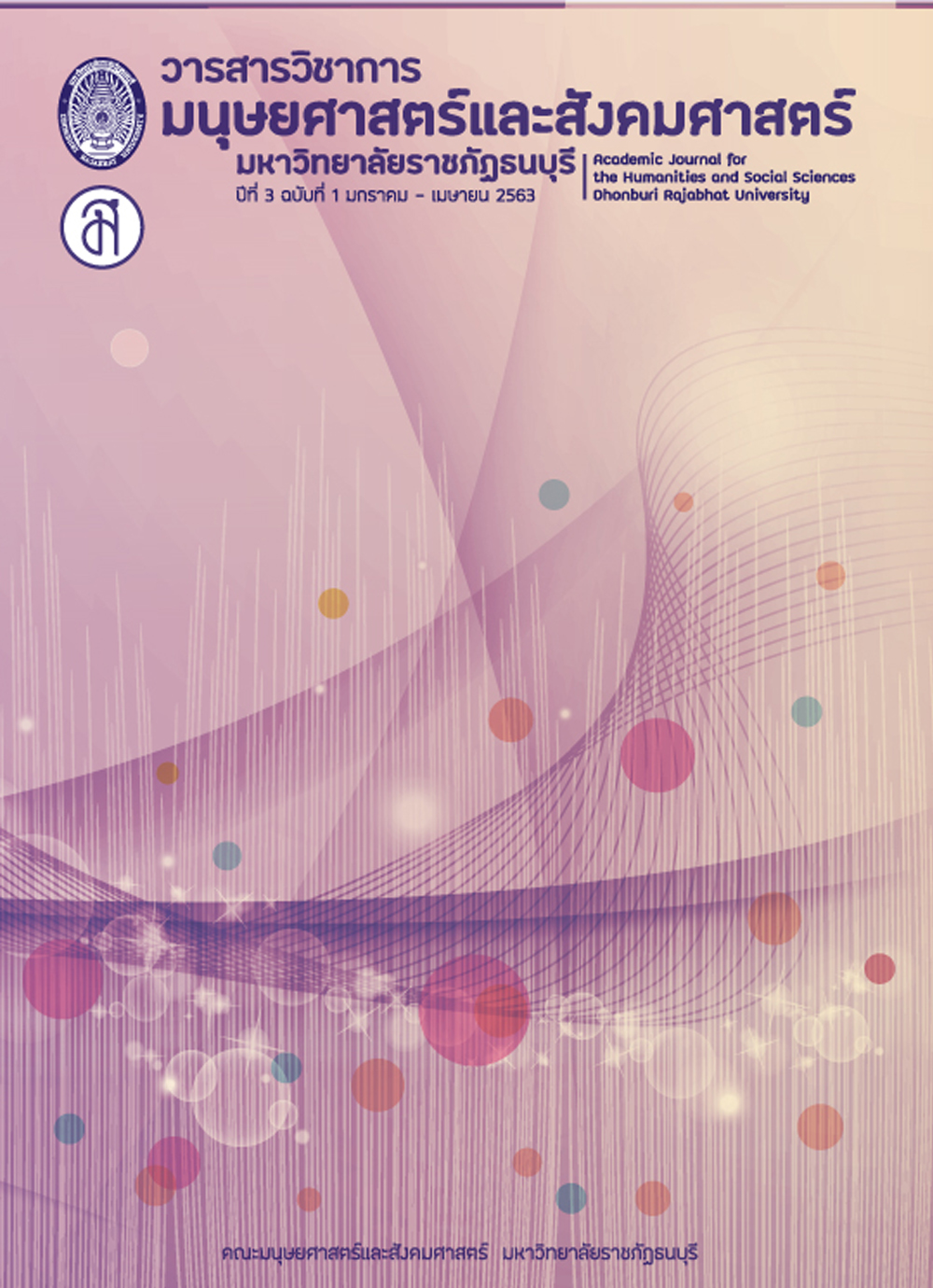การพัฒนาการออกเสียงของนักศึกษาสาขาวิชาภาษาอังกฤษ โดยใช้ระบบประมวลภาษา
คำสำคัญ:
การออกเสียงภาษาอังกฤษ, ระบบประมวลภาษา, สัทศาสตร์ภาษาอังกฤษบทคัดย่อ
งานวิจัยครั้งนี้มีวัตถุประสงค์เพื่อศึกษาพัฒนาการการออกเสียงพยัญชนะภาษาอังกฤษ/θ/, /ð/และ /dʒ/ ก่อนและหลังใช้แอปพลิเคชันระบบประมวลภาษา และเพื่อสำรวจความพึงพอใจของนักศึกษาต่อการใช้แอปพลิเคชันโดยเก็บข้อมูลกับนักศึกษาชมรมสัทศาสตร์ จำนวน 37 คน เครื่องมือที่ใช้ในการเก็บข้อมูล ได้แก่แบบทดสอบการออกเสียงแอปพลิเคชัน “English Pronunciation” และแบบสอบถามข้อมูลที่ได้นำมาประมวลผลโดยใช้สถิติเชิงพรรนณาผลการวิจัยแสดงให้เห็นว่านักศึกษามีพัฒนาการในการออกเสียงพยัญชนะภาษาอังกฤษหลังใช้แอปพลิเคชันและมีความพึงพอใจต่อการใช้แอปพลิเคชัน “English Pronunciation” อยู่ในระดับมาก (x̅= 4.41) เมื่อพิจารณาเป็นรายข้อ พบว่านักศึกษาพึงพอใจต่อการแสดงสัญลักษณ์สัทศาสตร์ (งานวิจัยครั้งนี้มีวัตถุประสงค์เพื่อศึกษาพัฒนาการการออกเสียงพยัญชนะภาษาอังกฤษ/θ/, /ð/และ /dʒ/ ก่อนและหลังใช้แอปพลิเคชันระบบประมวลภาษา และเพื่อสำรวจความพึงพอใจของนักศึกษาต่อการใช้แอปพลิเคชันโดยเก็บข้อมูลกับนักศึกษาชมรมสัทศาสตร์ จำนวน 37 คน เครื่องมือที่ใช้ในการเก็บข้อมูล ได้แก่แบบทดสอบการออกเสียงแอปพลิเคชัน “English Pronunciation” และแบบสอบถามข้อมูลที่ได้นำมาประมวลผลโดยใช้สถิติเชิงพรรนณาผลการวิจัยแสดงให้เห็นว่านักศึกษามีพัฒนาการในการออกเสียงพยัญชนะภาษาอังกฤษหลังใช้แอปพลิเคชันและมีความพึงพอใจต่อการใช้แอปพลิเคชัน “English Pronunciation” อยู่ในระดับมาก (x̅ = 4.41) เมื่อพิจารณาเป็นรายข้อ พบว่านักศึกษาพึงพอใจต่อการแสดงสัญลักษณ์สัทศาสตร์ (x̅ = 4.68) การประยุกต์ใช้ที่เป็นประโยชน์ในการเรียนการสอน (x̅ = 4.62) และการแสดงเนื้อหาทางสัทศาสตร์ (x̅ = 4.59) มากตามลำดับ x̅ = 4.68) การประยุกต์ใช้ที่เป็นประโยชน์ในการเรียนการสอน (x̅ = 4.62) และการแสดงเนื้อหาทางสัทศาสตร์ (x̅= 4.59) มากตามลำดับ
เอกสารอ้างอิง
Association of Southeast Asian Nations. (2017). the ASEAN Charter.Jakarta: Community Relations Division (CRD) of ASEAN Secretariat.
Bowman, M. (2000). A contrastive analysis of English and Thai and its practical application for teaching English pronunciation. The English Teacher, 4(1), pp. 40-53.
Chakma, S. (2014). Difficulty in pronunciation of certain English consonant sounds. SripatumChonburi Journal, 10(3), pp. 110-118.
Darasawang, P. (2007). English language teaching and education in Thailand: A decade of change. inD. Prescott (Ed.). English in Southeast Asia: Varieties, Literacies and Literatures Newcastle (pp. 187-204). Cambridge: Cambridge Scholars Publishing.
Dee-in, W. (2006). The development of computer- assisted instruction lessons promoting oral skills forEnglish problem sound for students of English majoringin International Communication, Rajamangala Universityof Technology LannaPhitsanulok Campus. Unpublished master’s thesis,UttaraditRajabhat University.
Defense Language Institution. (1974). A Contrastive study of English and Thai. Retrieved from https://eric.ed.gov/?id=ED105775
Educational Testing Service. (2011). Test and score data summary for TOEFL®Internet-based and paper-based tests. New Jersey: Educational Testing Service.
Farhat, P.A., &Dzakiria, H. (2017). Pronunciation barriers and computer assisted language learning(CALL): coping the demands of 21stcentury in Second Language learning classroom in Pakistan. International Journal of Research in English Education, pp. 53-62.
Fraser, H. (2000). Coordinating Improvements in pronunciation teaching for adult Learners of English as a Second Language. Canberra: DETYA (ANTA Innovative Project).
Galabo, N.R. (2019). Canteen service quality and student satisfaction. International Journal of Scientific and Technology Research, 8(6), pp. 114-126.
Garrigues, S. (1999). Overcoming pronunciation problems of English teachers in Asia. Retrieved from http://asianbridges.com/pac2/presentations/garrigues.html
Gilakjani, A.P. (2018). Teaching pronunciation of English with computer technology: a qualitative study. International Journal of Research in English Education, 3(2), pp. 94-114.
Jantharavijor, W. (2019). Improving English consonants pronunciation of undergraduate students in Rajamangala University of technology LannaLampang. TNI Journal of Business Administration and Languages, 2(7), pp. 32-41.
Jukpim, C. (2009). An investigation of KU CSC students pronunciation performance reflects pronouncingneeds improving. In English and Literatures-in-English in a Globalised World: Proceedings of the 13th International Conference on English inSoutheast Asia.Singapore, 2009: pp. 378-385.
Kanokpermpoon, M. (2007). Thai and English consonantal sounds: a problem or a potential for EFL Learning? ABAC Journal, 27(1), pp. 57-66.
Kenworthy, J. (1987). Teaching English Pronunciation. New York: Longman.
Khamkhien. A. (2010). Thai Learners’ English Pronunciation Competence: Lesson Learned from Word Stress Assignment. Journal of Language Teaching and Research, 1(6), pp. 757-764.
Lamarca, C.A.,Surasin, J., & Varasarin, P. (2016). Explicit pronunciation instruction to improve Thai vocational college students’ intelligibility. HRD Journal, 1(7), pp. 7-17.
Lu, L. (2010). Language transfer: from topic prominence to subject prominence. Unpublished master’s thesis, University of Leeds.
Ministry of Education. (2008). The basic education core curriculum. Bangkok: The Ministry of Education.
Nadkarni, M.P., Ohno-Machado, L., & Chapman, W.W. (2011). Natural language processing: an Introduction. J Am Med Inform Assoc, 8, pp. 544-551.
Noom-Ura, S. (2013). English-Teaching problems in Thailand and Thai teachers’ professional development needs. English Language Teaching, 6(11), pp. 139-147.
Raja, R., &Nagasubramani, P.C. (2018). Impact of modern technology in education.Journal of Applied and Advanced Research, 3(1), pp. 33-35.
Richards, J.C., & Schmidt, R. (Eds.). (2002). Longman dictionary of language teaching and Applied Linguistics. New York: Longman
Rosyid, A. (2016). Factors affecting EFL learners in learning English pronunciation. JournalIlmiahPendidikan, 2(8), pp. 436-443.
Sahatsathatsana, S. (2017). Pronunciation problems of Thai students learning English
Phonetics: a case study at Kalasin University. Journal of Education, Mahasarakham University, 11, pp. 67-84
Saville-Troike, M. (2012). Introducing Second Language Acquisition. New York: Cambridge University Press.
Senel, M. (2006). Suggestions for beautifying the pronunciation of EFL learners in Turkey. Journal of Language and Linguistic Studies, 2(1), pp. 111-125.
Tuaycharoen, P. (2003). A Reflection of Thai English. Journal of Language and Linguistics, 21(2), 47-65.
Tutorials Point. (2019). Natural language processing. Retrieved from https://www.tutorialspoint.com/natural_language_processing/natural_language_processing_tutorial.pdf
Weinberger, A., Fischer, F., & Mandl, H. (2002). Fostering individual transfer and knowledgeconvergence in text-based computer-mediated communication. In G. Stahl (Ed.), Computersupport for collaborative learning: Foundations for a CSCL community. Proceedings of CSCL 2002. Mahwah, NJ: Lawrence Erlbaum.
Winaithan, W., & Suppasetseree, S. (2012). The investigation of English pronunciation errors and factors affecting English pronunciation of Thai undergraduate students. Silpakorn Educational Research Journal, 4(2), pp. 304-320.
Wei, F., & Zhou, Y. (2002). Insights into English pronunciation problems in Thai students. Retrieved from http://www.eric.ed.gov/PDFS/ED476746.pdf
Yangklang, W. (2006). Improving English final /-l/ pronunciation of Thai students through computer-assisted instruction program. Unpublished doctoral’s dissertation, Suranaree University of Technology.
Yoshida, T.M. (2018). Choosing technology tools to meet pronunciation teaching and learning goals. The CATESOL Journal, 30(1), pp. 195-212.
ดาวน์โหลด
เผยแพร่แล้ว
รูปแบบการอ้างอิง
ฉบับ
ประเภทบทความ
สัญญาอนุญาต

อนุญาตภายใต้เงื่อนไข Creative Commons Attribution-NonCommercial-NoDerivatives 4.0 International License.
บทความที่ได้รับการตีพิมพ์เป็นลิขสิทธิ์ของ คณะมนุษยศาสตร์และสังคมศาสตร์ มหาวิทยาลัยราชภัฏธนบุรี
- บทความในวารสารวิชาการมนุษย์และสังคมศาสตร์ มหาวิทยาลัยราชภัฏธนบุรี เป็นความคิดเห็นของผู้นิพนธ์ ไม่ใช่ความคิดเห็นของกองบรรณาธิการ และไม่ใช่ความรับผิดชอบของกองบรรณาธิการและ/หรือของคณะมนุษยศาสตร์และสังคมศาสตร์ มหาวิทยาลัยราชภัฏธนบุรี
- กองบรรณาธิการไม่สงวนสิทธิ์ในการคัดลอก แต่ให้อ้างอิงแสดงที่มา
- บทความที่ได้รับตีพิมพ์จะมีการตรวจความถูกต้องเหมาะสมจากกองบรรณาธิการและผู้ทรงคุณวุฒิในสาขาที่เกี่ยวข้อง (peer review) จำนวน 3 คน โดยผู้ทรงคุณวุฒิจะไม่ทราบผู้นิพนธ์ และผู้นิพนธ์ไม่ทราบชื่อผู้ทรงคุณวุฒิ (double-blind peer review)




